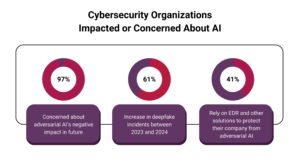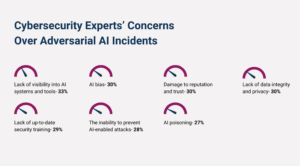Artificial Intelligence is spreading its influence far and wide, impacting nearly every aspect of our lives, including cybersecurity. But let’s face it- AI isn’t flawless. When the system you trust to shield your organization does blunder, it’s more than frustrating, it’s a critical moment of vulnerability.
Imagine missing a critical threat because the system flagged a hundred false positives or scrambling to respond after a delayed detection. It’s enough to shake anyone’s confidence in AI.
But here’s the thing, these stumbles aren’t just problems; they are wake-up calls. They are chances to rethink, refine, and build a security strategy that’s not just reactive but also resilient. After all, every setback is just a setup for a comeback.
AI can improve cybersecurity by automating threat detection and response. However, it’s important to ensure that AI systems themselves are secure. To make the most of AI while reducing risks, we need strong security measures, preventive safeguards, and ongoing monitoring.
AI Meets Cybersecurity: Where Promise Stumbles Over Reality!
AI in cybersecurity, although highly effective, can introduce new vulnerabilities if not managed correctly. Challenges such as adversarial AI, insufficient transparency, and the rise of deepfake threats emphasize the importance of careful integration and ongoing monitoring.
A survey by Deep Instinct, conducted among cybersecurity firms and their experts, highlights growing concerns about adversarial AI and the risks associated with over-reliance on AI. The survey points to challenges such as lack of visibility, AI bias, and the threat of deepfakes, all of which undermine security measures and expose organizations to new risks and vulnerabilities.


Here are some shortcomings of AI in cybersecurity:
1. Adversarial Attacks: AI systems are susceptible to adversarial machine learning, where malicious actors exploit their algorithms by providing misleading input data.
2. Inability to Adapt to New Threats: Many AI systems rely on historical data for training. When facing novel, adaptive cyberattacks like malware or advanced persistent threats, they often fail to respond effectively.
3. False Alarms and Fatigue: AI can produce excessive false positives, overwhelming cybersecurity teams and causing them to ignore critical alerts.
4. AI-Powered Cyberattacks: Cybercriminals are increasingly leveraging AI for sophisticated attacks, such as deepfake-based social engineering and AI-enhanced phishing, which bypass traditional security measures.
These findings highlight the growing concern about the vulnerabilities AI introduces in cybersecurity systems. Here are a few ways cybersecurity service providers can turn AI failures into strategic opportunities:
How Can We Optimize AI to Transform Cybersecurity?
Here’s how AI can create a paradigm shift in cybersecurity by transforming traditional reactive defense strategies into proactive and predictive one:
1. AI-Powered Threat Detection and Anomaly Detection
AI models analyze massive datasets in real time to identify patterns and detect anomalies that may signal a potential threat. Behavioral analytics can differentiate between normal and suspicious activity, even for zero-day attacks.
Through AI-based anomaly detection, AI systems can be trained to identify subtle deviations in user behavior, email patterns, and network traffic that may indicate AI-driven malicious activities.
For instance, AI can analyze email metadata to detect AI-generated phishing emails that mimic legitimate sources with accuracy, flagging them before they reach employees’ inboxes.
Value Enhancement
- This can provide proactive defense by identifying subtle, hard-to-spot deviations in user behavior or system patterns.
- It can help stop AI-driven attacks like phishing or malware injections before they can exploit vulnerabilities, ensuring stronger, real-time protection.
2. Deepfake Anomaly Detection As deepfake technology becomes more realistic, AI algorithms can be developed to analyze videos and audio recordings for inconsistencies, such as irregular facial movements, voice distortions, or background artifacts that are common in AI-generated content.
By training AI models on vast datasets of both authentic and manipulated media, these systems can detect deepfakes and prevent cyber criminals from leveraging them for social engineering attacks.
Additionally, natural language processing (NLP) models can be used to detect AI-enhanced phishing attempts. These models can understand and analyze the linguistic patterns of phishing emails, including subtle psychological tactics that AI might employ to manipulate victims into clicking malicious links or sharing sensitive information.
By identifying these advanced techniques, AI can quarantine these attacks before they even make it to a user’s inbox.
Value Enhancement
- This can safeguard organizations from advanced social engineering attacks.
- Analyzing inconsistencies in content and media can help verify the authenticity of media, preventing cybercriminals from exploiting deepfake to manipulate, impersonate, or deceive individuals or teams.
3. Adaptive Defense
Adaptive defense systems powered by AI can actively learn from new attack vectors, evolving alongside the tactics used by cybercriminals.
By leveraging AI to combat AI-powered cyberattacks, organizations can create a dynamic, self-adjusting defense strategy that stays ahead of increasingly sophisticated threats.
This approach; using AI to defend against and counter AI-powered attacks, ensures that cybersecurity systems are not only keeping up with current threats but are also prepared for the future of cybercrime.
Value Enhancement
- Adaptive defense systems provide resilience by evolving in real time to counter new threats. Through continuous learning, they ensure security measures remain effective against emerging AI-enhanced tactics, minimizing risk and ensuring that organizations stay one step ahead of adversaries.
AI is not just about speed; it’s also about precision and how it is used. Consciously using AI can be a win-win for both efficiency and effectiveness.
Network Intelligence’s AI Edge: Transforming Cybersecurity with Transilience AI
At Network Intelligence, we didn’t just adopt AI, we made it the backbone of our innovation. We developed Transilience AI which is our smart vulnerability management solution.
Security teams are buried under endless patch reports, trying to figure out what’s critical and what’s not. Vendor advisories pile up, each more confusing than the last, demanding time and attention. This constant chaos isn’t just a hassle, it’s a disaster waiting to happen.
Here’s where our AI-powered solution, Transilience AI, helps:
- Compliance Coverage & Audit Automation: Streamline audits, spot gaps, and create policies, saving time and improving compliance
- Non-Compliance Resolution Efficiency: Prioritizes and addresses non-compliance areas
- Enhanced Vulnerability Prioritization: Assists your team to take quick action on high-priority vulnerabilities, prioritizing important concerns and reducing noise
- Accelerated Time-to-Patch (TTP): Facilitates faster patching by finding and prioritizing fixes
- Improved Detection Response Metrics: Collects indicators from multiple sources and optimizes detection metrics. Reduces your team’s monitoring and detecting time
- Contextual Threat Intelligence Correlation: Compiles data from various sources to help your team gain insights and save their time
The results are quick and impressive with Transilience. The manual sorting process can be eliminated, allowing teams to save valuable weekly hours.
Actionable Wins with Transilience AI
- With Transilience AI, we were able to shrink audit workload for our clients by 80% and development teams have seen a 70% drop in wasted patching efforts.
- Vulnerabilities were reduced by 90%. It’s not just about reducing these numbers; it’s about restoring control to security teams.
Hence, security teams can relax and concentrate on high-priority tasks, rather than chasing paperwork or unnecessary patches.
AI doesn’t just stop attacks; it learns and evolves with every threat, making cybersecurity smarter and more adaptive. From identifying vulnerabilities in real time to predicting future attack patterns, AI is a game-changer for proactive defense.
Organizations can further strengthen AI’s role by investing in quality data, fostering collaboration across the industry, and actively training systems to detect emerging threats.
Which sectors do you think AI is having the largest impact on, and how can we shape its potential to redefine cybersecurity? Share your thoughts in the comments below!
Author
-

Richa Arya is the Senior Executive Content Marketer and Writer at Network Intelligence with over 5 years of experience in content writing best practices, content marketing, and SEO strategies. She crafts compelling results-driven narratives that align with business goals and engage audiences while driving traffic and boosting brand visibility. Her expertise lies in blending creativity with data-driven insights to develop content that resonates and converts.
View all posts
